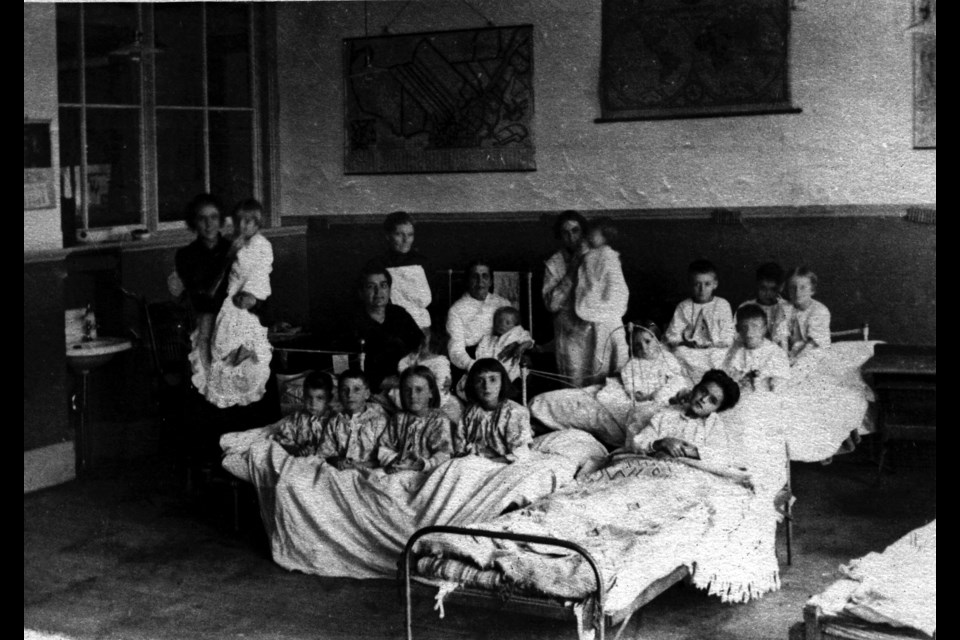As people today grow weary of dealing with COVID-19, it wasn’t the first time the Porcupine Camp has had to deal the threat of a virus.
The Spanish flu epidemic, which spread worldwide from 1918-1920, hit the North in the fall of 1918. It took longer for the Spanish flu to reach the region as travelling to the Porcupine was more difficult than it is today.
As with COVID, major flu outbreaks came in waves for Canadians. The first was in the spring of 1918. In the fall, a mutation made the virus more infectious, creating a second wave. This outbreak caused about 90 per cent of the deaths in Canada. There were two more waves in the springs of 1919 and 1920, but the impacts weren’t as harsh.
The second wave hit Timmins, as reported in the October 1918 edition of The Porcupine Advance under the headline First Death in Town Following Influenza.
“Timmins so far has escaped the ravages of the prevalent epidemic of the Spanish Influenza, but the first death in town from the complications following the disease occurred in Timmins last week when Mrs. O. Martell passed away at the Windsor Hotel after an illness of a few days. Death resulted from pneumonia, which followed an attack of influenza.”
Martell and her family of seven children came from St. Jerome, Que., as her husband found work with the Mattagami Pulp & Lumber Co. She was sick by the time they reached the Porcupine Camp, and was isolated at the hotel, where she received medical care. Her age was listed as “about 30.”
The same edition provided news of a former resident who died from the flu in Sudbury.
“Harry J. Lavery, well-known and popular in the Porcupine Camp, died in St Joseph’s Hospital, Sudbury, last week. He was taken suddenly ill in the Nickel Range Hotel shortly after his arrival in Sudbury and died after only three days’ illness. At first, he was suffering from Spanish influenza and then developed acute spinal meningitis.”
Lavery was a mining engineer and worked at The Dome Mines and at the Newray when it was taken over by the Porcupine Crown. According to the Advance, “his athletic ability won him special notice”, particularly as the first baseman for The Big Dome.
Like today, frontline workers were the heroes of the epidemic. Laura Keon was a nurse who came to Timmins from the Pembroke area to visit a cousin in August. She stayed to practice nursing, but died from the flu three months after arriving. The Nov. 6, 1918 Advance described her local work.
“When the emergency hospital was opened here, she was placed in charge of the volunteer nurses and she gave the most tireless and devoted service to the work. During the early days of the epidemic, when the conditions were most trying and the work most undesirable, her services were invaluable and her courage and effort beyond praise.”
The town council of the day committed to memorializing Keon. Just last April, the current city council decided to carry out that plan. Approval was granted to install a plaque in memory of Keon.
The location for the plaque is still under discussion, but it is hoped to be in place by the early summer.
Concern spread throughout the North as the Spanish flu arrived. While not as extensive as in southern and eastern Ontario, cases were reported in Haileybury and Cobalt. Local officials there closed down schools, theatres and churches as a precautionary measure.
There was no vaccination or drugs available at the time for preventing or treating the Spanish flu.
In Timmins, the local Board of Health issued printed notices suggesting ways to avoid catching the Spanish flu. These included: avoiding bad air, avoiding crowds, avoiding infected persons, and keeping good physical condition. It also advised residents with a bad cold or symptoms to take no chances but see a doctor, go to bed and stay there until better.
Similarly, the Porcupine Health Unit has issued advice during the current pandemic to reduce the spread of COVID. These include limiting close contact to members of your immediate household, maintaining physical distancing, following provincial gathering limits, washing hands frequently with soap and water or hand sanitizers, wearing a mask, frequently cleaning commonly touched surfaces, and proper coughing and sneezing etiquette.
The Jan. 8, 1919, Advance provided the death count from the first two waves of the Spanish flu.
“According to the official figures just available, 7,281 persons died in Ontario from the influenza epidemic, 2,067 of these deaths being in Toronto. In October there were 3,105 deaths, in November 2,608 and December, 1,568 from influenza.”
Spanish flu hit Canada between 1918 and 1920, killing about 55,000. Poor quarantine measures and a lack of national co-ordination hurt the efforts of doctors, nurses and volunteers. The epidemic led to the creation of the federal Department of Health in 1919. Municipal and provincial authorities tried to save lives by banning public gatherings and by isolating the sick. But these efforts had little effect.
The epidemic impacted the economy as workers grew ill, particularly in the wake of more than 60,000 Canadians dying and another 172,000 wounded during the First World War. Doctors, nurses, volunteers visited the sick and their families to deliver health care and supplies.
The Spanish flu was responsible for over 500 million infections worldwide and more than 50 million deaths. In Canada, there were more than 55,000 deaths.
Recent estimates from the WHO (World Health Organization) COVID-19 Tracker are 423,889,473 cases worldwide and 5,827,852 deaths. In Canada, the number of infected so far is estimated at 3,241,442 and more than 36,006 deaths. These numbers are still climbing.
Today, residents hope when the pandemic ends that they won’t have to battle another epidemic in the future. It’s the same hope early residents had more than 100 years ago.
